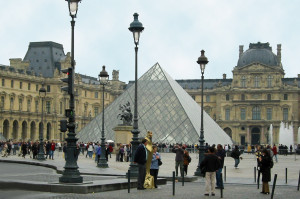
Entry Pyramid at Louvre Museum (Photo by Don Knebel)
The Louvre, a former fortress, was renovated in 1546 as a residence of King Francis I. Francis, a patron of the arts, summoned to Paris a number of Italian artists, including Leonardo da Vinci, who brought with him an unfinished Mona Lisa. Francis eventually acquired the completed Mona Lisa, which hung on the palace walls of a succession of French rulers until 1800, when it was placed in the Louvre, which became a national museum during the French Revolution. The Mona Lisa was stolen in 1911. When it was finally recovered in 1914, the previously little-known painting was an international sensation. Millions of people began coming to the Louvre just to get a glimpse of Da Vinci’s now famous work.
By the early 1980s, the Louvre’s crowds were overwhelming its traditional doorways, so President Mitterrand commissioned the design of a new entrance. The winning idea, submitted by American architect I. M. Pei, was a 69-foot-high glass and metal pyramid in the center of the courtyard, allowing visitors to enter through a large underground lobby. Critics immediately pounced on the pyramid design as incongruous with the Renaissance style of the building. Rumors began circulating that Mitterrand had ordered that the pyramid, a shape long associated with the occult, include exactly 666 glass panes, a number often connected to Satan. Dan Brown perpetuated this claim in The Da Vinci Code.
Today, the Louvre’s pyramid has become as much a symbol of Paris as the Eiffel Tower, itself lambasted when new. Visitors who carefully count the glass panes consistently come to 673.
Comments are closed.